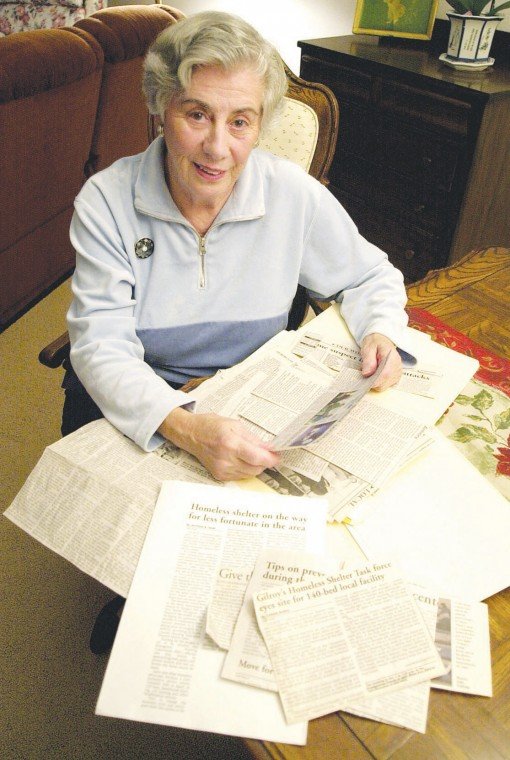GILROY
– While more homeless and unfortunate people may seek refuge at
the temporary homeless shelter at the Gilroy National Guard armory
this year in hopes of escaping the cold of winter and economic
upheaval, longtime volunteers and homeless advocates are still
buoyed by a new sense of optimism.
GILROY – While more homeless and unfortunate people may seek refuge at the temporary homeless shelter at the Gilroy National Guard armory this year in hopes of escaping the cold of winter and economic upheaval, longtime volunteers and homeless advocates are still buoyed by a new sense of optimism.
That’s because after nearly a decade of dreaming and much hard, hard work – including forays from direct humanitarianism into the spectrum of local politics – advocates won a key fight this year with the city’s approval of a Monterey Road site for a new, permanent homeless transitional center.
Yet, in a sense, there’s only time for a short breath for the myriad volunteers carrying the torch for the homeless crusade in Gilroy and South County. There’s still plenty to do to ensure the permanent shelter – which will offer social services meant to get the homeless back on their feet – becomes a reality.
“The interesting thing is that the work is just beginning,” said Maria Skoczylas, a retired school teacher and longtime Gilroy homeless activist who became one of the figureheads in the recent fight for the transitional center site.
For example, Skoczylas herself got involved with the armory shelter the first night it opened in the mid-1980s and soon became a fixture there over the years, performing a number of different roles. She had always stressed the importance of caring for others to her children, and it seemed like the perfect situation to demonstrate that, she said.
“It was just here’s a great need and a great opportunity where instead of ‘talk talk talk,’ you could do it,” Skoczylas said. “You could help your fellow man.”
But the fight for the permanent shelter took local activists who were used to helping the less-fortunate through direct contact and empathy into a new realm: local politics.
Advocates eventually formed several different working groups to help carry the vision forward, Skoczylas said. One shaped a vision for the shelter. Another worked with city planners trying to get permission for such a facility. Another, more formal homeless task force followed to put on the full-court press to secure a site and get it approved by the city.
It was a new, excruciatingly slow and sometimes discouraging process to advocates who were used to the more face-to-face and immediate gratification of helping others through the temporary shelter.
“It was a question of getting local people together who were interested and then getting the powers-that-be to meet with you,” Skoczylas said, who self-effacingly describes her role as “a nagger” in the process.
It all built to a crescendo last fall and winter, when advocates met several times a week both internally and with potential site neighbors in order to explain the facility and win approval.
The process was contentious – but it paid off with an unanimous City Council vote.
“I was stunned,” Skoczylas said. “I could not believe it happened. You’ve used all your energies.
“The next day you say, ‘Did this really happen?’ ”
One strong constant factor in the fight against homelessness is the support of Gilroy’s religious and ministerial community, Skoczylas said. Although it’s impossible to single any one out, members ranging from the Catholic, Baptist, Methodist, Lutheran and Presbyterian and Latter-Day Saints congregations – have all pitched in to varying degrees, from sheltering homeless to providing space for meetings.
And they’re the source of countless volunteers.
“Whenever we’ve really needed people to support us, they’ve come,” Skoczylas said.
Another constant was the help of veteran administrators at the nonprofit Emergency Housing Consortium and South County Housing, she said, whose leaders such as Barry Del Buono, Dennis Lalor, Jan Lindenthal and Mary Iserman were always accessible and came well-armed with information and experience during the process of getting the Monterey Road site approved.
Meanwhile, local officials such as District 1 County Supervisor Don Gage and Gilroy Mayor Tom Springer were also able to provide both much-needed clout, insight and perspective for shelter advocates, she said, educating them about the political process while providing encouragement and faith.
“It’s a torturous process for a layman,” she said. “But they were constantly saying, ‘It’s going to be, it’s going to work out.’ ”
In the meantime, work goes on at the armory shelter. For example, in recent years Budd Argyle has faithfully taken over the role of longtime fixture Florence Trimble in finding volunteers to staff the front desk – and greeting them with compassion and caring.
“It’s just a really good feeling,” said the 77-year-old, who’s been involved at the armory for nearly a decade. “There’s just nothing I know that can compare to helping someone that’s down.”And looking at this week’s shelter attendance as a barometer, Skoczylas said with the economy in the doldrums, it will probably be a record year.
“I think it will be a really very busy year,” she said. “We’re going to have huge numbers.”
And there’s still much to do to get the transitional center open. Advocates will help politicians and administrators look to secure millions of dollars in funding for construction, furnishings – the government doesn’t fund that – a good staff, proper transportation and make sure the facility complies with regulations.
But there are plenty of people still on the cause. After all, they’ve come this far.
“I can’t let it go,” Skocyzlas said of the homeless cause. “It becomes part of your life. Other than my family, it’s the most important thing in my life.”













